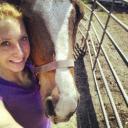Yahoo Answers is shutting down on May 4th, 2021 (Eastern Time) and beginning April 20th, 2021 (Eastern Time) the Yahoo Answers website will be in read-only mode. There will be no changes to other Yahoo properties or services, or your Yahoo account. You can find more information about the Yahoo Answers shutdown and how to download your data on this help page.
Trending News
URGENT! Back conformation on OTTB?
Have the chance to adopt this guy but I'm worried about his loin area. Anybody seen this before? I will NOT have a chance for vetting before deciding. I want a 3"max h/j/foxhunter but am willing to rehab.
3 Answers
- EvieLv 58 years agoFavorite Answer
Don't buy a horse with hunter's bumb... 70% of the time it leads to expensive vets bills later in life.
- 8 years ago
Don't buy.Hunter's bump in the horse is a term used to describe a condition in which the tuber sacrale of the pelvis, located at the highest point of the horse's rump, are abnormally prominent. Most people think of this condition as being a breed-specific conformation issue. It is often found in the "hunter/jumper" breeds like Thoroughbreds and Warmbloods. Some people even think this is actually a good thing and was an indication that a horse would be a good jumper because it is so prevalent in that discipline! Most often, however, it is either a function of how the horse is used; i.e. its job and how it uses it's body, or due to an old injury. there are many muscles that affect the action of both the hip and pelvis. Injury and/or strain to any one of these can have a significant effect on a horse's performance and range of motion to the hindquarters. When injury or strain occurs, the adjacent muscles take up the slack for the injured one. Depending on the nature of the injury, such as when ligaments are involved, the muscles will sometimes take over as stabilizers to limit the motion of a particular joint in an effort to avoid further damage to the injury site. Over time, and especially if a condition becomes chronic, the compensating soft tissue becomes overworked itself and prone to injury. The muscles remain in a constant state of contraction and fatigue easily. As the horse's body continues to compensate for the injury, certain muscles can become atrophied when they are no longer used as much and others become overdeveloped by comparison. The new compensated way of moving becomes an ingrained pattern in the horse's muscle memory and the body is less and less likely to return to a state of balance on its own even after the original injury has healed. Now add into that mix the creation of scar tissue, which is not very elastic and greatly reduces the available range of motion to the surrounding soft tissue. With hunter's bump, constant strain on the sacroiliac joint and ligaments due to awkward landings over jumps, falls, overwork or bad footing can cause damage to the ligaments and soft tissue of the pelvis. Atrophy begins to occur in the muscles overlying the tuber sacrale, and along with the upward movement of the sacroiliac joint, causes the characteristic "bump" along the top of the horse's rump. Most horses with hunter's bump will also have associated lumbar back pain. If the original injury has gone untreated for a long period of time, other conditions can begin to crop up due to the strain of compensation over time. You might see stifle and/or hock issues begin to crop up as secondary conditions to the original injury. These secondary conditions will usually persist and/or worsen even with treatment if the original culprit is not recognized and addressed first.
- KatLv 48 years ago
from what I here jumper's bump is not good at all! I wouldn't pay a dime for this horse
also his front pasterns seem really long and a bit upright for their length.
no no no no, you definitely could do better





